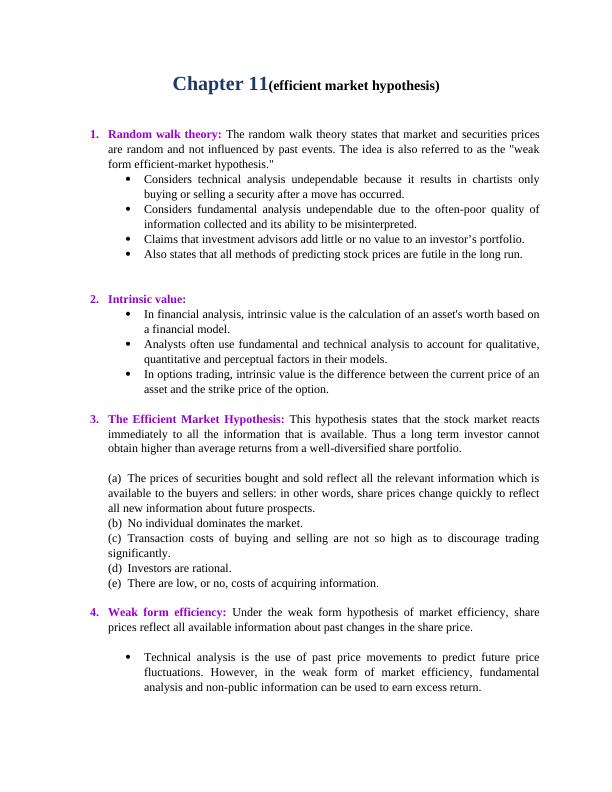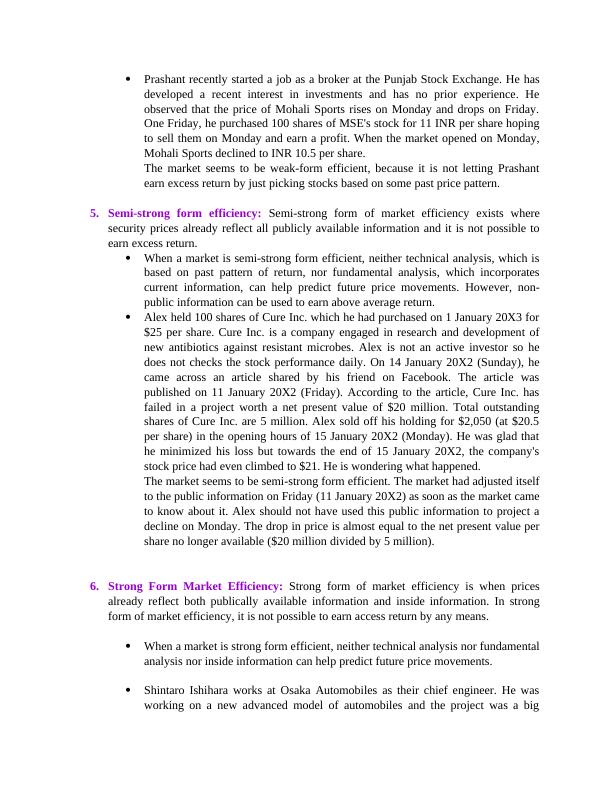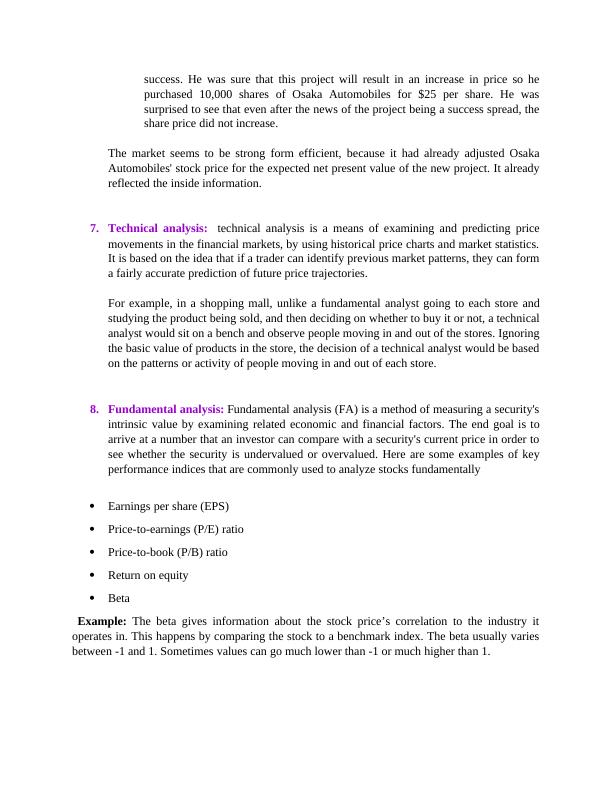Chapter 11 Efficient Market Hypothesis
Added on 2021-09-18
8 Pages3249 Words35 Views
Chapter 11(efficient market hypothesis)
1. Random walk theory: The random walk theory states that market and securities prices
are random and not influenced by past events. The idea is also referred to as the "weak
form efficient-market hypothesis."
Considers technical analysis undependable because it results in chartists only
buying or selling a security after a move has occurred.
Considers fundamental analysis undependable due to the often-poor quality of
information collected and its ability to be misinterpreted.
Claims that investment advisors add little or no value to an investor’s portfolio.
Also states that all methods of predicting stock prices are futile in the long run.
2. Intrinsic value:
In financial analysis, intrinsic value is the calculation of an asset's worth based on
a financial model.
Analysts often use fundamental and technical analysis to account for qualitative,
quantitative and perceptual factors in their models.
In options trading, intrinsic value is the difference between the current price of an
asset and the strike price of the option.
3. The Efficient Market Hypothesis: This hypothesis states that the stock market reacts
immediately to all the information that is available. Thus a long term investor cannot
obtain higher than average returns from a well-diversified share portfolio.
(a) The prices of securities bought and sold reflect all the relevant information which is
available to the buyers and sellers: in other words, share prices change quickly to reflect
all new information about future prospects.
(b) No individual dominates the market.
(c) Transaction costs of buying and selling are not so high as to discourage trading
significantly.
(d) Investors are rational.
(e) There are low, or no, costs of acquiring information.
4. Weak form efficiency: Under the weak form hypothesis of market efficiency, share
prices reflect all available information about past changes in the share price.
Technical analysis is the use of past price movements to predict future price
fluctuations. However, in the weak form of market efficiency, fundamental
analysis and non-public information can be used to earn excess return.
1. Random walk theory: The random walk theory states that market and securities prices
are random and not influenced by past events. The idea is also referred to as the "weak
form efficient-market hypothesis."
Considers technical analysis undependable because it results in chartists only
buying or selling a security after a move has occurred.
Considers fundamental analysis undependable due to the often-poor quality of
information collected and its ability to be misinterpreted.
Claims that investment advisors add little or no value to an investor’s portfolio.
Also states that all methods of predicting stock prices are futile in the long run.
2. Intrinsic value:
In financial analysis, intrinsic value is the calculation of an asset's worth based on
a financial model.
Analysts often use fundamental and technical analysis to account for qualitative,
quantitative and perceptual factors in their models.
In options trading, intrinsic value is the difference between the current price of an
asset and the strike price of the option.
3. The Efficient Market Hypothesis: This hypothesis states that the stock market reacts
immediately to all the information that is available. Thus a long term investor cannot
obtain higher than average returns from a well-diversified share portfolio.
(a) The prices of securities bought and sold reflect all the relevant information which is
available to the buyers and sellers: in other words, share prices change quickly to reflect
all new information about future prospects.
(b) No individual dominates the market.
(c) Transaction costs of buying and selling are not so high as to discourage trading
significantly.
(d) Investors are rational.
(e) There are low, or no, costs of acquiring information.
4. Weak form efficiency: Under the weak form hypothesis of market efficiency, share
prices reflect all available information about past changes in the share price.
Technical analysis is the use of past price movements to predict future price
fluctuations. However, in the weak form of market efficiency, fundamental
analysis and non-public information can be used to earn excess return.

Prashant recently started a job as a broker at the Punjab Stock Exchange. He has
developed a recent interest in investments and has no prior experience. He
observed that the price of Mohali Sports rises on Monday and drops on Friday.
One Friday, he purchased 100 shares of MSE's stock for 11 INR per share hoping
to sell them on Monday and earn a profit. When the market opened on Monday,
Mohali Sports declined to INR 10.5 per share.
The market seems to be weak-form efficient, because it is not letting Prashant
earn excess return by just picking stocks based on some past price pattern.
5. Semi-strong form efficiency: Semi-strong form of market efficiency exists where
security prices already reflect all publicly available information and it is not possible to
earn excess return.
When a market is semi-strong form efficient, neither technical analysis, which is
based on past pattern of return, nor fundamental analysis, which incorporates
current information, can help predict future price movements. However, non-
public information can be used to earn above average return.
Alex held 100 shares of Cure Inc. which he had purchased on 1 January 20X3 for
$25 per share. Cure Inc. is a company engaged in research and development of
new antibiotics against resistant microbes. Alex is not an active investor so he
does not checks the stock performance daily. On 14 January 20X2 (Sunday), he
came across an article shared by his friend on Facebook. The article was
published on 11 January 20X2 (Friday). According to the article, Cure Inc. has
failed in a project worth a net present value of $20 million. Total outstanding
shares of Cure Inc. are 5 million. Alex sold off his holding for $2,050 (at $20.5
per share) in the opening hours of 15 January 20X2 (Monday). He was glad that
he minimized his loss but towards the end of 15 January 20X2, the company's
stock price had even climbed to $21. He is wondering what happened.
The market seems to be semi-strong form efficient. The market had adjusted itself
to the public information on Friday (11 January 20X2) as soon as the market came
to know about it. Alex should not have used this public information to project a
decline on Monday. The drop in price is almost equal to the net present value per
share no longer available ($20 million divided by 5 million).
6. Strong Form Market Efficiency: Strong form of market efficiency is when prices
already reflect both publically available information and inside information. In strong
form of market efficiency, it is not possible to earn access return by any means.
When a market is strong form efficient, neither technical analysis nor fundamental
analysis nor inside information can help predict future price movements.
Shintaro Ishihara works at Osaka Automobiles as their chief engineer. He was
working on a new advanced model of automobiles and the project was a big
developed a recent interest in investments and has no prior experience. He
observed that the price of Mohali Sports rises on Monday and drops on Friday.
One Friday, he purchased 100 shares of MSE's stock for 11 INR per share hoping
to sell them on Monday and earn a profit. When the market opened on Monday,
Mohali Sports declined to INR 10.5 per share.
The market seems to be weak-form efficient, because it is not letting Prashant
earn excess return by just picking stocks based on some past price pattern.
5. Semi-strong form efficiency: Semi-strong form of market efficiency exists where
security prices already reflect all publicly available information and it is not possible to
earn excess return.
When a market is semi-strong form efficient, neither technical analysis, which is
based on past pattern of return, nor fundamental analysis, which incorporates
current information, can help predict future price movements. However, non-
public information can be used to earn above average return.
Alex held 100 shares of Cure Inc. which he had purchased on 1 January 20X3 for
$25 per share. Cure Inc. is a company engaged in research and development of
new antibiotics against resistant microbes. Alex is not an active investor so he
does not checks the stock performance daily. On 14 January 20X2 (Sunday), he
came across an article shared by his friend on Facebook. The article was
published on 11 January 20X2 (Friday). According to the article, Cure Inc. has
failed in a project worth a net present value of $20 million. Total outstanding
shares of Cure Inc. are 5 million. Alex sold off his holding for $2,050 (at $20.5
per share) in the opening hours of 15 January 20X2 (Monday). He was glad that
he minimized his loss but towards the end of 15 January 20X2, the company's
stock price had even climbed to $21. He is wondering what happened.
The market seems to be semi-strong form efficient. The market had adjusted itself
to the public information on Friday (11 January 20X2) as soon as the market came
to know about it. Alex should not have used this public information to project a
decline on Monday. The drop in price is almost equal to the net present value per
share no longer available ($20 million divided by 5 million).
6. Strong Form Market Efficiency: Strong form of market efficiency is when prices
already reflect both publically available information and inside information. In strong
form of market efficiency, it is not possible to earn access return by any means.
When a market is strong form efficient, neither technical analysis nor fundamental
analysis nor inside information can help predict future price movements.
Shintaro Ishihara works at Osaka Automobiles as their chief engineer. He was
working on a new advanced model of automobiles and the project was a big

success. He was sure that this project will result in an increase in price so he
purchased 10,000 shares of Osaka Automobiles for $25 per share. He was
surprised to see that even after the news of the project being a success spread, the
share price did not increase.
The market seems to be strong form efficient, because it had already adjusted Osaka
Automobiles' stock price for the expected net present value of the new project. It already
reflected the inside information.
7. Technical analysis: technical analysis is a means of examining and predicting price
movements in the financial markets, by using historical price charts and market statistics.
It is based on the idea that if a trader can identify previous market patterns, they can form
a fairly accurate prediction of future price trajectories.
For example, in a shopping mall, unlike a fundamental analyst going to each store and
studying the product being sold, and then deciding on whether to buy it or not, a technical
analyst would sit on a bench and observe people moving in and out of the stores. Ignoring
the basic value of products in the store, the decision of a technical analyst would be based
on the patterns or activity of people moving in and out of each store.
8. Fundamental analysis: Fundamental analysis (FA) is a method of measuring a security's
intrinsic value by examining related economic and financial factors. The end goal is to
arrive at a number that an investor can compare with a security's current price in order to
see whether the security is undervalued or overvalued. Here are some examples of key
performance indices that are commonly used to analyze stocks fundamentally
Earnings per share (EPS)
Price-to-earnings (P/E) ratio
Price-to-book (P/B) ratio
Return on equity
Beta
Example: The beta gives information about the stock price’s correlation to the industry it
operates in. This happens by comparing the stock to a benchmark index. The beta usually varies
between -1 and 1. Sometimes values can go much lower than -1 or much higher than 1.
purchased 10,000 shares of Osaka Automobiles for $25 per share. He was
surprised to see that even after the news of the project being a success spread, the
share price did not increase.
The market seems to be strong form efficient, because it had already adjusted Osaka
Automobiles' stock price for the expected net present value of the new project. It already
reflected the inside information.
7. Technical analysis: technical analysis is a means of examining and predicting price
movements in the financial markets, by using historical price charts and market statistics.
It is based on the idea that if a trader can identify previous market patterns, they can form
a fairly accurate prediction of future price trajectories.
For example, in a shopping mall, unlike a fundamental analyst going to each store and
studying the product being sold, and then deciding on whether to buy it or not, a technical
analyst would sit on a bench and observe people moving in and out of the stores. Ignoring
the basic value of products in the store, the decision of a technical analyst would be based
on the patterns or activity of people moving in and out of each store.
8. Fundamental analysis: Fundamental analysis (FA) is a method of measuring a security's
intrinsic value by examining related economic and financial factors. The end goal is to
arrive at a number that an investor can compare with a security's current price in order to
see whether the security is undervalued or overvalued. Here are some examples of key
performance indices that are commonly used to analyze stocks fundamentally
Earnings per share (EPS)
Price-to-earnings (P/E) ratio
Price-to-book (P/B) ratio
Return on equity
Beta
Example: The beta gives information about the stock price’s correlation to the industry it
operates in. This happens by comparing the stock to a benchmark index. The beta usually varies
between -1 and 1. Sometimes values can go much lower than -1 or much higher than 1.

End of preview
Want to access all the pages? Upload your documents or become a member.
Related Documents
(solved) Financial Market Essaylg...
|19
|4154
|233
Efficient Market Hypothesis Assignment Reportlg...
|12
|2959
|13
Efficient Market Hypothesis Assignmentlg...
|6
|2261
|465
Fundamental Features of Efficient Market Hypothesis (EMH) and CAPMlg...
|18
|4173
|96
Financial Investment Research Paper 2022lg...
|7
|1565
|23
Technical Analysis: A Tool for Stock Price Movement Predictionlg...
|13
|2912
|205